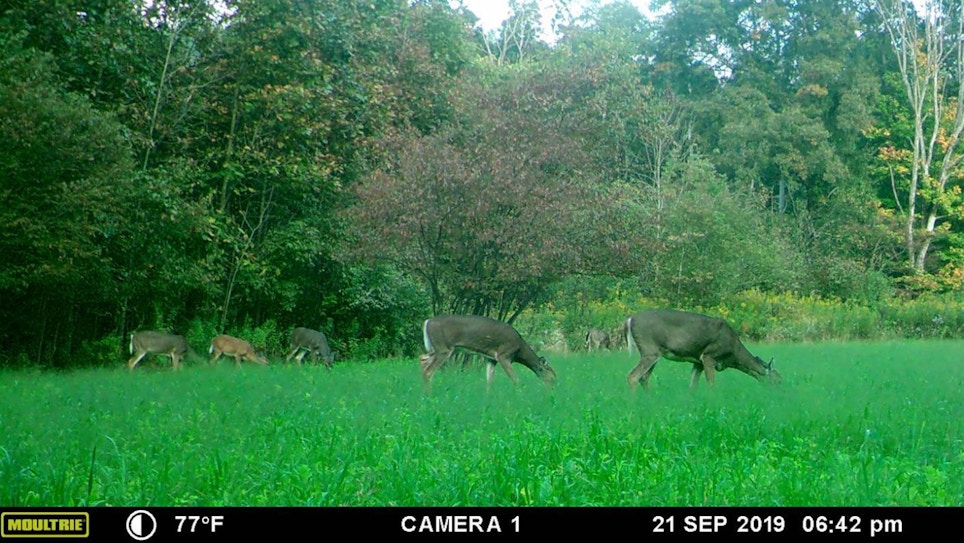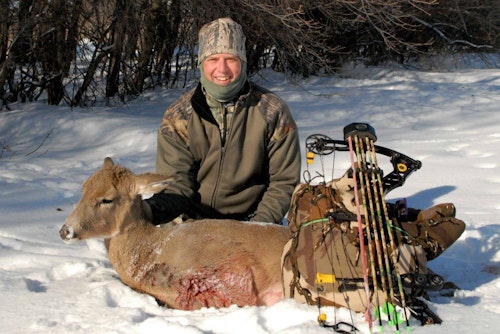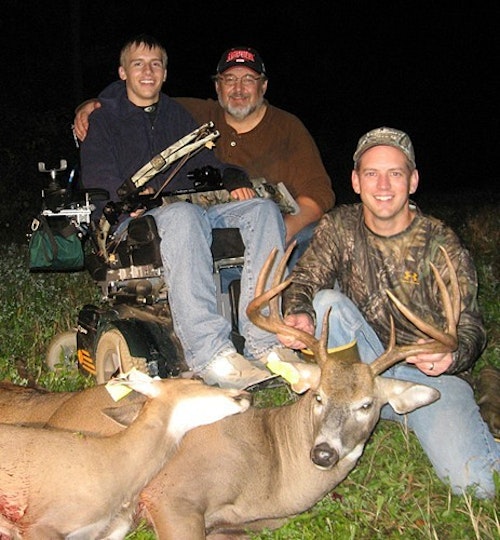
Doe and fawn families routinely visit green fields well before dark during September. In the author’s opinion, this is the ideal time to fill a doe tag or two.
Depending on where you pursue whitetails, there’s a good chance you have the opportunity to harvest one or more antlerless deer. In my western Wisconsin hunting area, for example, my nonresident archery deer tag includes one buck tag and two antlerless tags.
Because I like to eat venison and so do my two sons, I try to harvest two whitetails each season. Doing so provides enough venison for our family for one year. (If one of the deer is a big-bodied buck, then we have a bit extra and I’m able to give venison to others who will appreciate it.) The question I face each archery deer season is, “When should I try to shoot a doe?”
Waiting for Late Season
For many years, I waited until late season to try and fill antlerless deer tags in Wisconsin. I was successful at times, but more often than not it was a struggle to shoot a doe or two in December. Why?
For starters, by December, Wisconsin whitetails have been already pursued for a couple weeks by firearms hunters (late-November firearms season), and much longer by bowhunters (mid-September bow opener). Not only are there fewer whitetails walking around by December, but those that have survived several weeks of hunting pressure are smarter, or at least nocturnal — choose whichever term you think is the most accurate.
The only years where I experienced decent December hunting for Wisconsin whitetails is when my area was hit with a combination of deep snow and single-digit temperatures, which forced deer on their feet during legal hunting hours to feed in standing cornfields. During years with deep snow but mild temps, the deer didn’t have to move until after dark. The same was true for years with significant cold but minimal snow; I spotted almost no deer during legal shooting hours.

I hate to admit the number of times I burned an antlerless deer tag when I had room in my freezer. I simply couldn’t get the job done during late season even though I worked hard to do so.
Early Season Is Best
Like most deer hunters, I’m not interested in filling an antlerless deer tag during the whitetail rut (in Wisconsin, this means the first couple weeks of November). I’m dreaming of mature bucks during the rut, and any doe I see gets a free pass because I’m hoping a 30-pointer is on her tail.
This means the early season is prime time for me to fill doe tags. Sure, I might let a big doe pass through my shooting lane on the first evening or two of archery season because I’m hoping a mature buck will walk the same trail on his way to a lush green field, but trust me when I say I’ll begin targeting antlerless deer soon afterward.
Through the years I’ve learned that shooting a doe from a stand doesn’t necessarily mean the evening is ruined for a buck. In fact, I can remember several instances where a member of my hunting party (or me) shot a doe early in the evening and then shot a buck from the same stand 30-60 minutes later.
In general, the parade of whitetails on their way to a green field in the evening during early season begins with doe/fawn families, followed by young bucks, then finally the older bucks arrive on the scene. Even if an arrow-hit doe flees back into the forest, a buck on his way to the field might think she was simply spooked off the field by a passing vehicle, farmer’s tractor, etc. He’ll probably be more cautious, and might show up a few minutes later than normal, but chances are good he’ll still appear during legal shooting light.

Another advantage to filling antlerless deer tags early is it’s easy to distinguish a mature doe from her fawns. Even though it’s rare for fawns to still have spots in mid-September, there’s no danger in confusing a fawn for a doe during the early season. The doe/fawn families are almost always traveling together, so you’ll have the size comparison right there in front of you to witness, and the fawns are tiny. This isn’t true in December. Sure, the doe is bigger than her offspring during late season, too, but the difference isn’t as apparent because the fawn has been doing some serious catching up during September, October and November.
As I see it, the only downside to filling antlerless deer tags early is the heat. With mid-September daytime temperatures in the 70s and even 80s in Wisconsin, and nighttime lows in the 60s, there’s no waiting for morning to track and recover a deer that was hit poorly. And even if you make a double-lung shot and a doe doesn’t run far, you still have to think about meat care immediately.
Unless you have a walk-in cooler available, or know of a meat market that will accept deer well after regular store hours, you’ll have to butcher your doe that same night. This can be a hassle, certainly, but I’d rather stay up late butchering a fat doe and have meat in my freezer for the remainder of the year than purchase beef burger in January because I was unsuccessful filling a bonus tag in December. Of course, butchering chores are much easier to handle if you have help from a friend or two. Finally, there’s no better late-night September snack than fresh tenderloins on the grill as you finish processing your antlerless deer.





